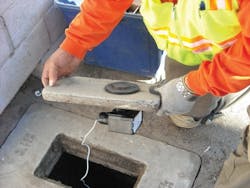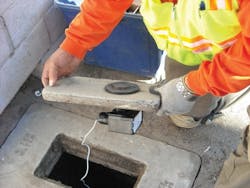Polyethylene Encasements Offer Corrosion Protection
By Brandon C. Jones
Polyethylene encasements can be an economical and no maintenance corrosion protection system for ductile iron pipe. They are an engineered corrosion control system using specially designed material with specific requirements that are outlined in national and international standards. Most of these requirements are outlined in the ANSI/AWWA C105/A21.5 specification and include strength, tear resistance, impact resistance, and dielectric strength.
Protection of the pipe is achieved by simply encasing it with either a tube or sheet of loose polyethylene at the job site immediately before installation. Once installed, polyethylene acts as an un-bonded film that prevents direct contact of the pipe with corrosive soil.
The wrap is not intended to be air tight or water tight. Any oxygen that is between the wrap and the pipe at the time of installation is not enough to support significant corrosion. Initially some surface oxidation may occur, however, the small amount of oxygen that exists is soon depleted and the wrap prevents any further oxygen from entering the space. The weight of the backfill and surrounding soil after installation prevents any significant exchange of groundwater between the wrap and the pipe. Although some groundwater may seep beneath the wrap, there is no oxygen left to support corrosion.
Encasements can be easy to repair if damaged during installation. Unlike bonded coating systems that require special surface preparation and complex mixing of chemicals, polyethylene encasements are repaired by simply placing a piece of corrosion resistant tape (PVC or Polyethylene) over the damaged area. Duct tape is not recommended as it will deteriorate over time and the exposed hole may let soil come in contact with the pipe. For larger damage, an additional piece of polyethylene may be secured over the area.
There are some cost considerations as well. Polyethylene encasements are inexpensive. The material costs as little as pennies per foot per inch diameter of pipe. They can be installed at the job site by the contractor hired to lay the pipe. Just slip the tube of polyethylene over the pipe and secure. It also costs nothing to operate once it is in the ground.
Research has shown the buried film does no degrade over time and compromise the system. After many test site exhumations and in-service inspections of exposure times up to 45 years, samples of the film have been tested by DIPRA (Ductile Iron Pipe Research Association). These tests include both wet and dry trench conditions in varying soil conditions. In every case, the film still exceeded the minimum physical requirements as defined in the ANSI/AWWA C105/A21.5 standard at the time of installation.
Polyethylene encasements can also be used to protect piping networks that don't include ductile iron pipe. Many other piping systems such as HDPE and PVC use bolt-on mechanical and restrained joints made from ductile iron. These joints do have a coating to help protect them; however, the bolts that are used often are not coated. This puts the system at risk for corrosion. Polyethylene encasements or specifically engineered polyethylene joint wrap can be used to protect such joints.
The efficiency of polyethylene encasement has sometimes been dismissed due to its simplicity. However, the system has proven successful in hundreds of field tests since the 1950s. More information, including data from field test investigations, can be found in "Polyethylene Encasement; Effective, Economical Protection for Ductile Iron Pipe in Corrosive Environments" published by DIPRA as well as "Corrosion and Corrosion Control of Iron Pipe: 75 years of Research" by Richard W. Bonds, Lyle M. Bernard, A. Michael Horton, and Gene L. Oliver. WW
About the Author: Brandon C. Jones works for AA Thread, a supplier of polyethylene encasements for ductile iron pipe. He is the third generation of family that works for the company that was founded in 1979 by his grandfather. For more information, visit www.aathread.com.
More WaterWorld Current Issue Articles
More WaterWorld Archives Issue Articles

